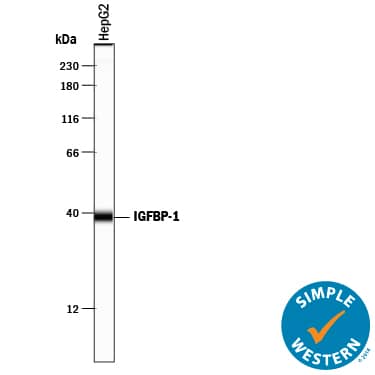Human IGFBP-1 Antibody
R&D Systems, part of Bio-Techne | Catalog # AF871


Key Product Details
Species Reactivity
Validated:
Cited:
Applications
Validated:
Cited:
Label
Antibody Source
Product Specifications
Immunogen
Ala26-Asn259
Accession # P08833
Specificity
Clonality
Host
Isotype
Scientific Data Images for Human IGFBP-1 Antibody
Detection of Human IGFBP‑1 by Western Blot.
Western blot shows lysates of HepG2 human hepatocellular carcinoma cell line. PVDF membrane was probed with 1 µg/mL of Goat Anti-Human IGFBP-1 Antigen Affinity-purified Polyclonal Antibody (Catalog # AF871) followed by HRP-conjugated Anti-Goat IgG Secondary Antibody (Catalog # HAF019). A specific band was detected for IGFBP-1 at approximately 28 kDa (as indicated). This experiment was conducted under reducing conditions and using Immunoblot Buffer Group 1.Detection of Human IGFBP‑1 by Simple WesternTM.
Simple Western lane view shows lysates of HepG2 human hepatocellular carcinoma cell line, loaded at 0.2 mg/mL. A specific band was detected for IGFBP-1 at approximately 39 kDa (as indicated) using 50 µg/mL of Goat Anti-Human IGFBP-1 Antigen Affinity-purified Polyclonal Antibody (Catalog # AF871) followed by 1:50 dilution of HRP-conjugated Anti-Goat IgG Secondary Antibody (Catalog # HAF109). This experiment was conducted under reducing conditions and using the 12-230 kDa separation system.Applications for Human IGFBP-1 Antibody
Simple Western
Sample: HepG2 human hepatocellular carcinoma cell line
Western Blot
Sample: HepG2 human hepatocellular carcinoma cell line
Formulation, Preparation, and Storage
Purification
Reconstitution
Formulation
Shipping
Stability & Storage
- 12 months from date of receipt, -20 to -70 °C as supplied.
- 1 month, 2 to 8 °C under sterile conditions after reconstitution.
- 6 months, -20 to -70 °C under sterile conditions after reconstitution.
Background: IGFBP-1
The superfamily of insulin-like growth factor (IGF) binding proteins include the six high-affinity IGF binding proteins (IGFBP) and at least four additional low-affinity binding proteins referred to as IGFBP related proteins (IGFBP-rP). All IGFBP superfamily members are cysteine-rich proteins with conserved cysteine residues, which are clustered in the amino- and carboxy-terminal thirds of the molecule. IGFBPs modulate the biological activities of IGF proteins. Some IGFBPs may also have intrinsic bioactivity that is independent of their ability to bind IGF proteins. Post-transitional modifications of IGFBP, including glycosylation, phosphorylation and proteolysis, have been shown to modify the affinities of the binding proteins to IGF.
Human IGFBP-1 cDNA encodes a 259 amino acid (aa) residue precursor protein with a putative 25 aa residue signal peptide that is processed to generate the 234 aa residue mature protein. IGFBP-1 contains an integrin receptor recognition sequence (RGD sequence) but lacks potential N-linked glycosylation sites. IGFBP-1 is expressed in liver, decidua, kidneys and is the most abundant IGFBP in amniotic fluid. Serum levels of IGFBP-1 are lowest after meals. Hepatocyte production of IGFBP-1 is regulated at the transcriptional level due to the affects of insulin and corticosteriods. IGFBP-1 binds equally well to IGF-I and IGF-II, with phosphorylated forms of IGFBP-1 exhibiting higher binding affinities.
References
- Jones, J.I. and D.R. Clemmons (1995) Endocrine Rev. 16:3.
- Kelley, K.M. et al. (1996) Int. J. Biochem. Cell Biol. 28:619.
Long Name
Alternate Names
Gene Symbol
UniProt
Additional IGFBP-1 Products
Product Documents for Human IGFBP-1 Antibody
Product Specific Notices for Human IGFBP-1 Antibody
For research use only
